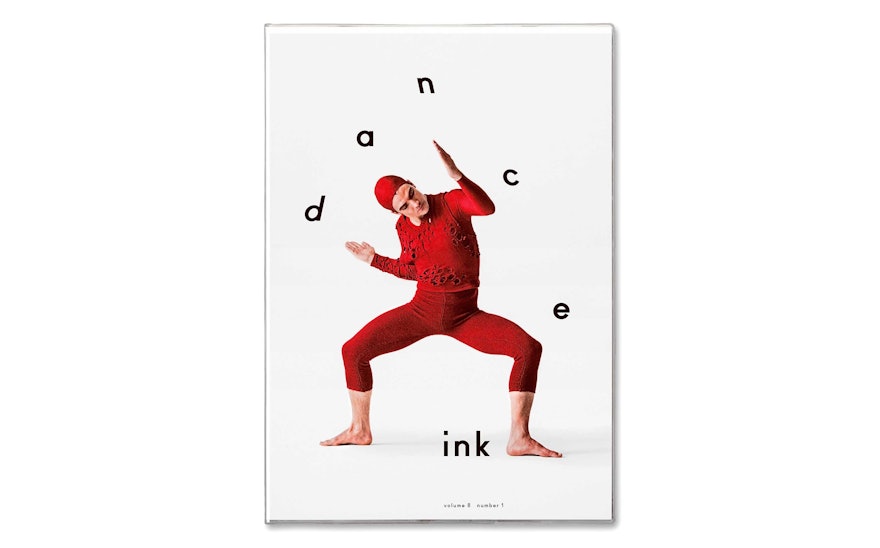Originally published from 1989 to 1996, Dance Ink was a maverick in the world of independent publishing, a performing arts journal that documented its community through the lens of new dance works commissioned specifically for the pages of the magazine. After 20 years, the pioneering quarterly is relaunching, its revival inspired by a new generation of dancers and performers and the resurgence in independent print media. Dance Ink is published by Patsy Tarr and designed and edited by Pentagram, both reprising their original roles.
The relaunch picks up where Dance Ink left off in 1996, with the publication of Volume 8, Number 1. The new issue returns to the original premise of creating a unique and enduring stage for dance, using great photography, powerful design and the beauty of high-quality printing. Conceived by Tarr as an alternative performance space, the magazine presents and preserves this most ephemeral of art forms for a wider audience. And this time, the magazine expands its performance space to a new stage: environmental installations, via posters and murals available on demand.
The new issue features an all-star group of three of the most acclaimed dancers working today: Amar Ramasar and Adrian Danchig-Waring, two of the principal dancers from the New York City Ballet, performing choreography by Justin Peck, the Ballet's resident choreographer; and Silas Riener, the final dancer to join the Merce Cunningham Company, who danced with the group from 2007 until its official closure in 2011. The issue was photographed by Christian Witkin, a frequent collaborator with 2wice, working here for the first time with Dance Ink.
During its original run, Dance Ink developed a cult following among dancers, photographers and designers, winning numerous awards for writing, photography and design. The eccentric and exuberant aesthetic of the magazine is now a time capsule of performance and downtown culture in New York City. In 1997, Tarr launched 2wice, a twice-yearly publication edited and designed by Pentagram with a broader purview of visual culture and the performing arts. Starting in 2011, 2wice chiefly existed as a series of apps that envisioned the iPad screen as a performance space that invited users to interact with choreography.
Dance Ink fills a unique niche in dance publishing and the performing arts world: There are dance magazines that report on the scene, and newspapers that review performances, but Dance Ink represents a more native extension of the dance community, a space to create and perform. Two decades after Dance Ink first pioneered the idea, no other publication is commissioning and staging new work. And since the first run of Dance Ink, there is an entirely new generation of performers and choreographers, many of whom remember the original magazine, or know of it as an artifact of an incredibly fertile period. Reintroducing the magazine allows it to engage with these new talents.
According to Tarr, the relaunch was inspired by her “desire to create a platform for the amazing new talent in performance, just as the original Dance Ink featured emerging and established figures in the 1990s.”
Beautifully produced through high-quality offset printing, the new magazine is housed in a clear sleeve, enhancing its tactility. Throughout the issue, the design plays with the effect of transparency of ink on the page, suggesting layers of performance and motion. The issue opens with a quote from Merce Cunningham, “We begin again.” The format continues the tradition of 2wice’s later issues, which mainly consisted of a single collaboration with a photographer and performer. As with 2wice, the look of the magazine will vary with every issue.
Appropriately, the first issue of the relaunch spotlights a new work and resurrects a lost classic. The three pieces in the magazine pay tribute to Merce Cunningham and George Balanchine, the two most influential choreographers from whom all dance essentially derives in the present. “Everywhere We Go” features black-and-white photography of the Balanchine-inspired choreography from Peck's ballet of the same name, performed by Ramar and Danchig-Waring, and eventually joined by Riener. Miller and Tarr previously collaborated with Peck on the 2wice app Passe-Partout.
The cover features an image from “Changeling,” a signature early work by Cunningham, here performed by Riener. First created in 1957, the performance was considered “lost” and only known through a few iconic photographs until a 1958 film recently resurfaced in a German archive, enabling the choreography to be restaged. Riener has since been entrusted by the Cunningham Trust to perform the piece around the country, beginning at the Institute of Contemporary Arts/Boston to accompany the recent exhibition Leap Before You Look: Black Mountain College 1933-1957. In the Dance Ink portfolio, he wears a costume originally designed by Cunningham’s close collaborator Robert Rauschenberg and recreates poses from the original photographs. These are now the only contemporary images of the work.
Riener also performs en plein air in Tompkins Square Park in New York’s East Village in “Leap Year,” photographed on February 29, the last day of the month in a leap year. Two short teaser films for the new issue were filmed during the shoot.
The new Dance Ink also experiments with multiple formats, moving from page to screen to walls. Two large-scale posters will be produced from every issue, and a pattern of images or a single image can be installed as a custom mural. These are available in a collaboration between Dance Ink and Dodge Chrome and can be ordered via the 2wice site.

